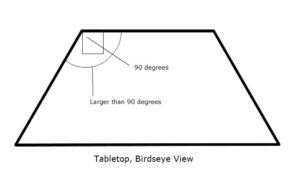 Have you ever tried to hang your coat over the corner of table? Unless it snags, it seems to always fall off. This question inspired two scientists in Chicago to do an analysis on the subject. To represent the coat, they used a string with two identical weights on each end, with the string laying over the table, and the weights hanging off the end.
Have you ever tried to hang your coat over the corner of table? Unless it snags, it seems to always fall off. This question inspired two scientists in Chicago to do an analysis on the subject. To represent the coat, they used a string with two identical weights on each end, with the string laying over the table, and the weights hanging off the end.
Sure enough, as the experience with the coat suggests, the string will slide off the corner of the table. This happens because as gravity pulls the weights downward, the distance between the weights gets shorter. The weights get closer and closer to the ground, until they slide the string completely off the table.
Up to this point, the physics is fairly intuitive, or at least believable. The scientists then carefully did the calculations representing the theory of what is happening when the weights fall off the table. The calculations were based upon the weights, the shape of the table, the incline of the table, the friction of the string with the table, and the swaying that the weights would naturally do as they moved off the table.
The results they found from this calculation showed something difficult to imagine. Even if the table is on an incline so that the corner is actually tilted upwards, the weights will still slide off the table if certain conditions are met!
 In order for this to happen, there must be as little friction as possible with the string and the table, meaning that the surface must be extremely smooth like metal or polished wood. Secondly, the table corner would need to be wider than 90 degrees. The ideal table for this experiment would be one that was cut poorly with one corner more obtuse than it was supposed to be — the table would no longer be a rectangle. If these two things are true, then the string with weights attached would slide up and over the corner, appearing to defeat an uphill battle with gravity!
In order for this to happen, there must be as little friction as possible with the string and the table, meaning that the surface must be extremely smooth like metal or polished wood. Secondly, the table corner would need to be wider than 90 degrees. The ideal table for this experiment would be one that was cut poorly with one corner more obtuse than it was supposed to be — the table would no longer be a rectangle. If these two things are true, then the string with weights attached would slide up and over the corner, appearing to defeat an uphill battle with gravity!
This happens because the table has a corner that is wider than 90 degrees will cause the weights to swing. In each swing, the string will jump up a little, closer toward the edge of the table. This causes the amount of string on the table to be less, and thus the weights hang farther from the table, and swing a little farther. This next swing causes the string to jump a little higher toward the edge of the corner. This process continues until the string slides or hops off the corner of the table.
This result is not intuitive and demonstrates that analysing seemingly simple problems can allow us to learn new things. This result is mainly used as a teaching tool for students to learn how to explain the world using equations instead of relying on their intuition. Furthermore, this result can be used when designing complex mechanical systems such as those used in manufacturing facilities. Nonetheless, this experiment is simple enough that it can be demonstrated at home as a clever party trick! Tie some fishing weights to a thin string and polish a piece of wood with a wide angle on it. Set the table at an incline, and watch physics in action!
Edited by Gina Riggio
Original Paper: https://doi.org/10.1119/1.4962226




